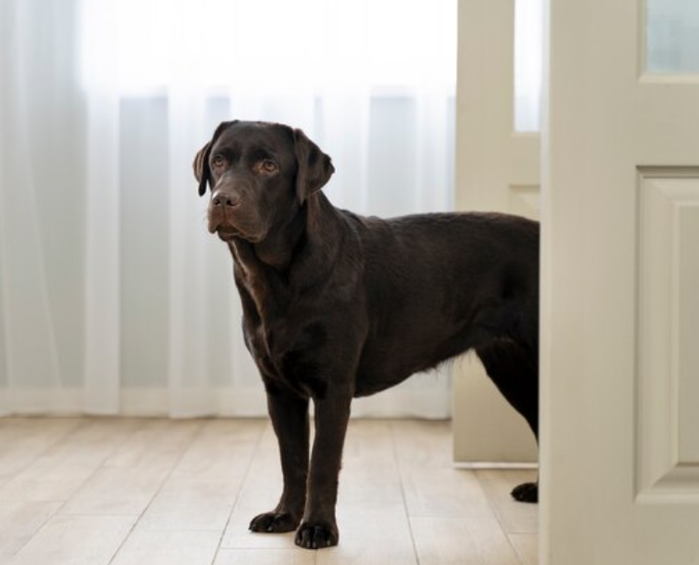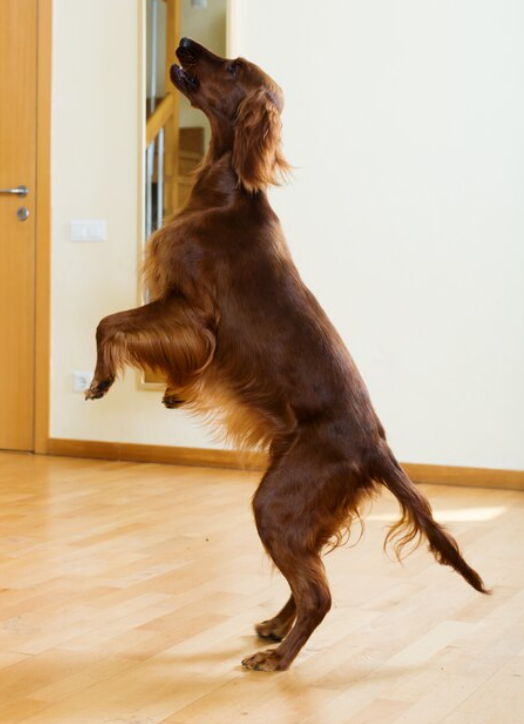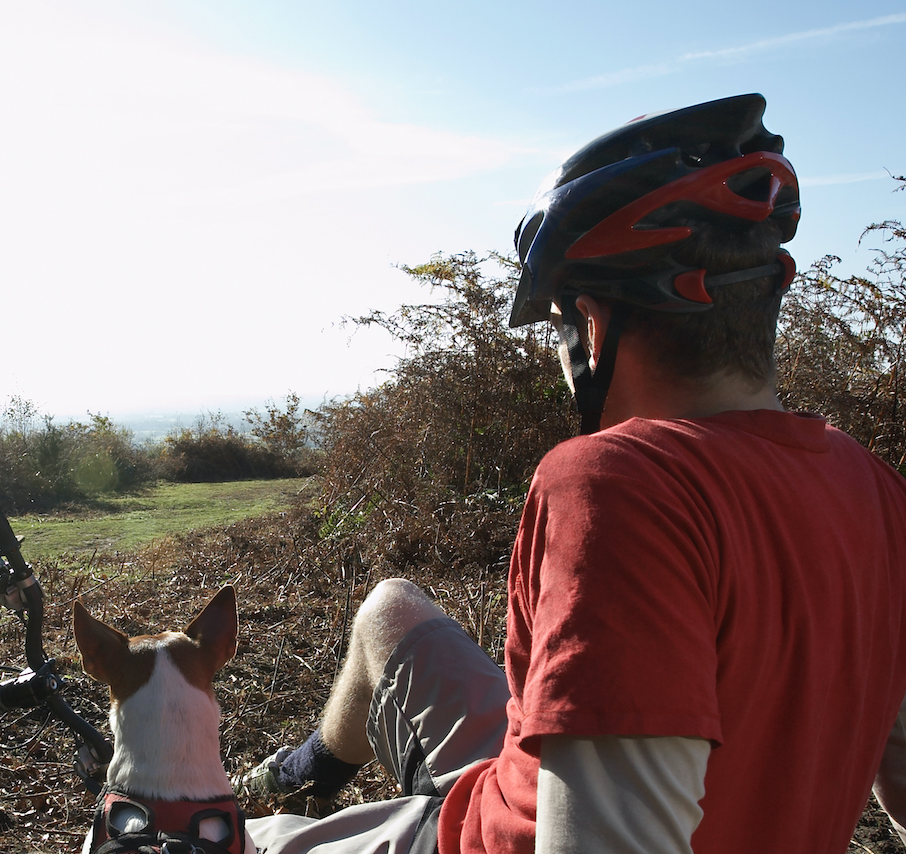
What to say about dogs? They are loyal, and affectionate, and give us their unconditional love, without waiting for anything in return. They are amazing creatures whose enthusiasm can be contagious!
Talking about enthusiasm, some canines tend to get enthusiastic and even hyper much easier than others. They are simply more energetic. Their high energy along with their protective instinct often manifests in undesired behaviors such as barking. Regardless of the particular reason for barking, this behavior usually makes us feel uncomfortable, especially when people approach the front door.
While it is natural for our paw friends to alert us to potential visitors or perceived threats, constant barking can become a nuisance. Fortunately, with the right approach, patience, and consistency, you can train your dog to be calm and well-mannered when faced with the sound of the doorbell or knocking.

Understanding the Reasons Behind Door Barking
The key to addressing barking at the door lies in understanding the causes of this behavior as a first step and utilizing positive reinforcement training techniques to address this behavior as a second step. Let’s start with the possible causes of door-related barking!
Territorial Instincts
Dogs, as descendants of wolves, have inherited their territorial instincts via evolution and have passed them down through generations.
When a dog perceives someone approaching their home, they may interpret it as a potential threat to their territory. This triggers a protective response, manifesting in vocalization such as barking. In the wild, this behavior aims to warn the other pack members of potential intruders.
While our beloved paw friends have been domesticated for a long time now, and may not face the same threats in their environments nowadays, this instinct remains deeply embedded. Having said that, they are very likely to interpret visitors as potential threats to their territory, causing them to bark as a response.
Through training, you can teach your dog to distinguish between friendly visitors and potential dangers, encouraging a more controlled response.
Excitement
Canines are inherently social animals and meeting new people can be thrilling for them!
Engaging in social interaction, along with the sensory stimuli associated with someone approaching the door, can trigger excitement. It, in turn, is very likely to find an expression in barking.
Channeling your paw friend’s excitement into more appropriate behaviors and introducing controlled interactions with people are highly recommended in this case. Needless to say, socialization plays an essential role here.
Fear / Anxiety
For some dogs, the barking at the door is a behavior, that is deeply rooted in fear or anxiety.
If your canine had negative experiences in the past, such as traumatizing encounters with strangers, or if they lack socialization, they might feel insecure and anxious when exposed to new situations and people.
Desensitization can be particularly effective in helping your dog overcome their anxiety. By exposing your canine to door-related stimuli in a positive and controlled environment, you can gradually help them build confidence and reduce anxiety triggers.
Lack of Training
Similar to humans, dogs also thrive on (proper) communication.
If you have not taught your canine alternative behaviors, i.e. remaining calm when someone approaches the door, they are likely to automatically start using vocalization as a default response.
It is essential, that you establish clear communication with your dog. If you are wondering what this means, we will be glad to clarify it! Clear communication means giving the dog commands and reinforcing the desired behavior understandably and clearly.
Many owners often lack proper communication with their dogs by unintentionally reinforcing negative behaviors, such as:
- Giving attention/treats to their dogs when they misbehave only to stop the unwanted behavior;
- Not rewarding the desired behavior in a timely manner may cause the dog to wonder what they are rewarded for;
- Not using the same cue words/commands for a specific behavior.
We, as owners, should set clear expectations and communicate them with our paw friends in a clear way.
Lack of Socialization
Proper socialization at a young age is not only the foundation of all future types of training but an essential factor in helping your dog become a confident, well-mannered, and happy member of society.
If your paw friend is used to meeting different types of people and animals and is exposed to various situations (gradually), they are much more likely to behave themselves when guests or visitors approach the front door.
When your canine is properly socialized, meeting new people won’t be a special event for them anymore but a part of their routine.

Training Methods to Address Barking at the Door
We will list below several approaches/techniques that can help you address this issue. The first thing to do is to identify the trigger that causes the unwanted reaction.
Identify Your Dog’s Triggers and Anticipating Their Reactions
Observe your dog's behavior to identify the specific triggers that lead to door-related barking. The stimuli can be related to the sound of the doorbell, knocks, or the sight of strangers.
On the other hand, the ability to anticipate your dog's reactions will allow you to intervene before the barking escalates.
Positive Reinforcement
Now that you have identified the stimuli, you should start working on addressing them properly. Positive reinforcement is probably the most frequently used training method that involves rewarding the dog for showing wanted behaviors. This encourages them to keep exhibiting these behaviors in the future as they lead to something positive (reward).
When your dog stays calm at the door, reward them with treats, toys, praise, and affection. This helps create a positive association with being quiet.
Here we need to note that identifying your dog’s motivators is as important as identifying their triggers.
Identify Your Dog’s Motivators
Most dogs are food-motivated, which usually makes it easy to apply positive reinforcement. When they show the desired behavior, they receive a treat as a reward. The more challenging the behavior is, the higher the value of the treats should be. In other words, you should reward your paw friend with very delicious treats such as pieces of chicken, turkey, string cheese, etc. when they do a task perfectly or when they struggle with the task a lot.
However, what is the case with dogs who are not food-motivated?
If your paw friend is a picky eater, then you should rather opt for toys, praises, and pets as positive reinforcement tools. Canines who are very emotionally tuned to their owners, often become very happy and motivated when praised enthusiastically (not too enthusiastically) by their beloved humans and pets for the job well done.
If your doggo has a favorite toy to play with, a quick play session with that toy or just handing the toy over to them, can be perceived as a reward.
Desensitization & Counter-Conditioning
Let’s talk about two of our favorite training approaches! Many of you may have already applied them without realizing it.
Desensitization is a term used to describe the process of gradually exposing the dog to the stimuli that trigger them (in this case, that trigger barking) by starting at a very low level. The level of exposure in the beginning should be so low that no reaction should follow.
Counter-conditioning means rewarding the dog in the presence of the stimuli (doorbell, knocks, sight of people or animals passing by) to help the dog change their attitude. Over time, your furry friend is likely to start pairing the stimuli with a reward, hence something positive.
Simply put, you can ask a family member or friend to ring the doorbell or knock while your dog is at a long distance (e.g., two rooms away), making the sound less clear to them. If they stay calm, reward them. If this approach is unlikely to work, you can play audio of the sounds on your phone or computer at a very low volume. If your paw friend remains calm, reward them. Increase the sound volume/ reduce the distance gradually.

Basic Obedience Training
Ensure your dog has a strong foundation in basic commands such as "sit" and "stay”. It is recommended that you use these commands consistently when addressing door-related barking. Reinforce the commands with positive reinforcement to strengthen the association.
If you would like to receive more detailed information on how to train your paw friend in basic obedience commands, the following article might be helpful: Dog Training Commands Every Dog Should Know
Signal for Quiet
Another method that might help you address unwanted door-related barking, is choosing a specific command or hand signal to indicate that your dog should be quiet.
Whether it's a verbal cue like "quiet" or a specific gesture, such as placing your finger to your lips, consistency is essential. Introduce the signal during training sessions focused on door-related barking, associating it with the expectation of calm behavior. When your dog settles down, reward them immediately.
Always keep in mind that patience and consistency are key factors in shaping a dog’s behavior and guiding it in the right direction.
Distractions
Provide your dog with a distracting toy or treat when someone is at the door. This can help redirect their focus and break the habit of barking.
Designated Safe Zone
Designate a specific area away from the front door where your dog can relax.
Use a comfortable bed or mat and reinforce the behavior of staying in this area with treats, toys, and positive reinforcement. Encourage your paw friend to go to their area when someone is approaching the door.
Relaxing Environment
Create a calming atmosphere when guests come to visit or if someone passes by your home.
Play soothing music or use calming pheromone diffusers to create a relaxed environment, helping your dog associate door-related sounds with a positive experience.












